Abstract
Genital and subjective sexual arousal in response to sexual imagery was studied. In a previous study subjects who were encouraged to process information on sexual stimuli and sexual responses were more sexually aroused than subjects encouraged to process information on sexual stimuli only. In the present study, the reverse effect was found in subjects who had received further verbal training to differentially process information on sexual stimuli or responses. This suggests two different kinds of processing information on sexual responses. They may result from simple encouragement or verbal training to process sexual information.
Similar content being viewed by others
References
Barlow, D. H. (1986) The causes of sexual dysfunction: the role of anxiety and cognitive interference.J. Consult. Clin. Psychol. 54: 140–148.
Barlow, D. H., Becker, R., Leitenberg, H., and Agras, W. (1970). Mechanical strain gauge recording of penile circumference change.J. Appl. Behav. Anal. 3: 73–76.
Carroll, D., Marzillier, J. S., and Merian, S. (1982) Psychophysiological changes accompanying different types of arousing and relaxing imagery,Psychophsiology, 19, 75–82.
Dekker, J., and Everaerd, W. (1988). Attentional effects on sexual arousal.Psychophysiology 25: 45–54.
Hays, W. L. (1973).Statistics Holt, Rinehart and Winston, New York.
Lang, P. J. (1984). Cognition in emotion: Concept and action. In Izard C., Kagan, J., and Zajone, R. (eds.),Emotion, Cognition and Behavior Cambridge University Press, New York.
Qualls, P. J. (1982). The Psychophysiological measurement of imagery: An overview.Imagination Cognition Pers. 2: 89–101.
Qualls, P. J., and Sheehan, P. W. (1979). Capacity for absorbation and relaxation during electromyograph biofeeback and no-feedback conditions.J. Abn. Psychol. 88: 652–662.
Qualls, P. J., and Sheehan, P. W. (1981a). Role of the feedback signal in electromyograph biofeedback: The relevance of attention.J. Exp. Psychol. Gen. 110: 204–216.
Qualls, P. J., and Sheehan, P. W. 1981b). Imagery encouragement, absorption capacity and relaxation during electromyograph biofeedback.J. Pers. Soc. Psychol. 41: 370–379.
Qualls, P. J., and Sheehan, P. W. (1981c). Electromyograph biofeedback as a relaxation technique: A critical appraisal and reassessment.Psychol. Bull. 90: 21–42.
Author information
Authors and Affiliations
Additional information
This research was supported by a grant from PSYCHON/Netherlands Organization for the Advancement of Pure Research (ZWO 56-205). This study was carried out at the Department of Clinical Psychology, University of Utrecht, The Netherlands. The views contained in this article are those of the authors and should not be construed as reflecting the views of any of the institutions mentioned above.
Rights and permissions
About this article
Cite this article
Dekker, J., Everaerd, W. A study suggesting two kinds of information processing of the sexual response. Arch Sex Behav 18, 435–447 (1989). https://doi.org/10.1007/BF01541974
Issue Date:
DOI: https://doi.org/10.1007/BF01541974




